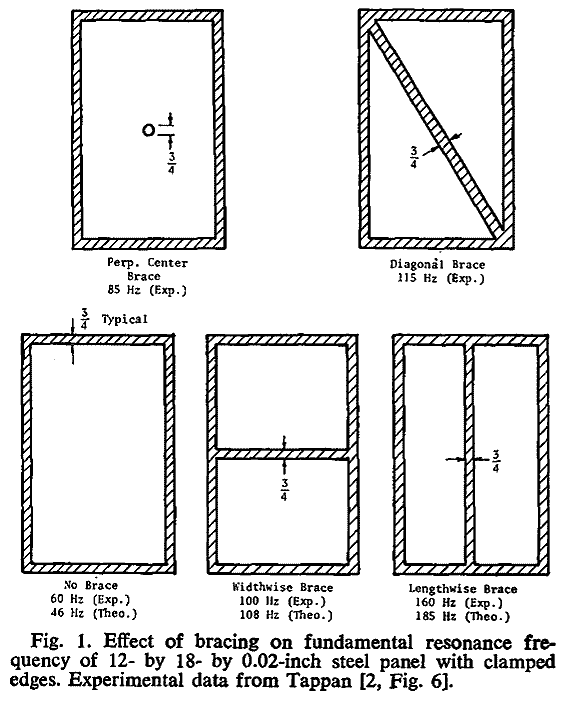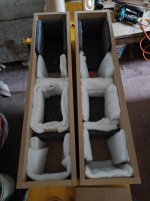I've just started my new speaker project, a 2 way floor standing using SB Acoustics drivers:
WF: SB17MFC35-8
TW: SB26STC-C000-4
Crossover point: 1700Hz
Box: 30 Liters
Tuning: 40Hz
Veneer: Oak
I'll post measurements down the road!




WF: SB17MFC35-8
TW: SB26STC-C000-4
Crossover point: 1700Hz
Box: 30 Liters
Tuning: 40Hz
Veneer: Oak
I'll post measurements down the road!
Since you have drawings and dimensions, can you share your enclosure volume calculations based on T/S parameters?
First, the distance from top to bottom is so large you will get a dominating resonance. Second the vent is so low, it will add to this problem.
So you are not building a BR, but some kind of transmission line.
Better don't close it and find a way to correct your design.
So you are not building a BR, but some kind of transmission line.
Better don't close it and find a way to correct your design.
To exand on Turbowatch, a BR assumes a shape that does not stray to far from a cube. As one dimension grows to be significantly larger then the others and the BR transforms into an ML-TL. The tuning usually ends up lower. Having the driver at one end, and the vent at the other maximizes the effect. Yours are close but the offset complicates things, a modeler will catch this, a BR modeler has no idea.
You bracing is minimal, better than nothing, but… and given the box looks to be MDF even more bracing than usual will be needed.

dave
You bracing is minimal, better than nothing, but… and given the box looks to be MDF even more bracing than usual will be needed.

dave
The blue is the new position of the vent, orange is fibre panel (MDF) maybe 16mm strong.
You may angle them up or down a bit, like 30° if you like it better. No need to be precise, it is just to prevent standing waves that would ruin your build.
If you have such a build and explore what happens, you may fill the lower 2/3 with Rockwool or acryl wool. This will damp the output from the vent, too.
Your build suffers from strong resonance around 190 and 380 Hz. This will be audible!
You may angle them up or down a bit, like 30° if you like it better. No need to be precise, it is just to prevent standing waves that would ruin your build.
If you have such a build and explore what happens, you may fill the lower 2/3 with Rockwool or acryl wool. This will damp the output from the vent, too.
Your build suffers from strong resonance around 190 and 380 Hz. This will be audible!
If you want to have a simple picture what happens inside such a cabinet, think of a large spring with a weight on the bottom.
Now pull on the weight and release. The weight will move up and down with a certain frequency. This is the resonance frequency of the spring/ weight combination. Now grab the spring at half it's length and move the weight. The frequency will be much higher. You can simply do such an experiment with a rubber string and a weight and play with a mass/spring system.
A resonace inside a speaker is just the same. You find such system's on countless occasions in life. Think of waves in a swimming pool, any exhaust system, musical instruments, oscillators in electronics...
So that is what we do inside your box: Right now we have a resonance at 190Hz for the distance of 910mm from top to bottom. Any time you play a sound around that frequency, it will resonate, turning an input of a "bam" into an output of "bammamamam...". You don't want that. So we cut the spring in smaller pieces and eliminate the low frequency resonance. Instead we have more of them at higher frequency. These have much less energy and can be controlled by some absorbing material at the walls. Also they have a tendency to cancel each other out. If you look at the edited picture of your box, I tried to not repeat distances between panels, which is important. Just make the distances differ little, like +-5cm to get different resonances. If you tilt them a little, it deflects even more, but don't go crazy on the whole thing, no need to spend night's calculating.
The good thing about these resonance prohibiting panel's, your build does not see them at the very low tuning frequency, like 30Hz. So the vented system will still work as planed.
Now pull on the weight and release. The weight will move up and down with a certain frequency. This is the resonance frequency of the spring/ weight combination. Now grab the spring at half it's length and move the weight. The frequency will be much higher. You can simply do such an experiment with a rubber string and a weight and play with a mass/spring system.
A resonace inside a speaker is just the same. You find such system's on countless occasions in life. Think of waves in a swimming pool, any exhaust system, musical instruments, oscillators in electronics...
So that is what we do inside your box: Right now we have a resonance at 190Hz for the distance of 910mm from top to bottom. Any time you play a sound around that frequency, it will resonate, turning an input of a "bam" into an output of "bammamamam...". You don't want that. So we cut the spring in smaller pieces and eliminate the low frequency resonance. Instead we have more of them at higher frequency. These have much less energy and can be controlled by some absorbing material at the walls. Also they have a tendency to cancel each other out. If you look at the edited picture of your box, I tried to not repeat distances between panels, which is important. Just make the distances differ little, like +-5cm to get different resonances. If you tilt them a little, it deflects even more, but don't go crazy on the whole thing, no need to spend night's calculating.
The good thing about these resonance prohibiting panel's, your build does not see them at the very low tuning frequency, like 30Hz. So the vented system will still work as planed.
You picked a good tweeter.
As far as bracing goes, just add a few triangles to the corners that reach into half the panel widths. Bracing into the corner is always better than front to back without tying into the sides as well. Youll want to add a brace every 6 to 8 inches. You will end up with one significant internal standing wave with your design, which can be minimized by placing some dampening material in the middle of the box.
As far as bracing goes, just add a few triangles to the corners that reach into half the panel widths. Bracing into the corner is always better than front to back without tying into the sides as well. Youll want to add a brace every 6 to 8 inches. You will end up with one significant internal standing wave with your design, which can be minimized by placing some dampening material in the middle of the box.
Attachments
X-over will be the fun part, i will measure the speakers response in the box, then I'll simulate the crossover with my measurements.
But still I think I'll cross then at 1,7kHz
But still I think I'll cross then at 1,7kHz
Last edited:
Waveguides are very fancy, but not a "must have". You can buy most tweeter with a facory optimised WG, I would prefer such instead of experimenting with an unknown result. Not all tweeter react well to any WG. For a beginner an additional part will complicate things.
Do not X too low. 2kHz seems the limit for this tweeter with 12-18dB/oct. Below that distortion will rise too much. The PP woofer has a very well behaved response, it will except an even higher x-over point.
Do not X too low. 2kHz seems the limit for this tweeter with 12-18dB/oct. Below that distortion will rise too much. The PP woofer has a very well behaved response, it will except an even higher x-over point.
- Home
- Loudspeakers
- Multi-Way
- Floor standing AudioFlix - 2 way SB Acoustics


